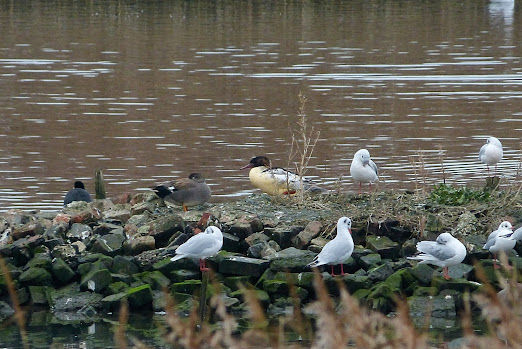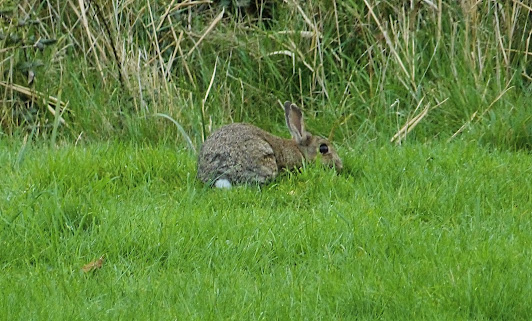Saturday 16th November 2024.
Today did not go as according to plan as I had decided to take the journey to Splash Point, East Sussex for the long-staying female Pied Wheatear. However, by the time Geoff and I got to Andy’s house, there was no sighting of the bird according to Birdguides. So bloody typical. One gets to Saturday and the bird disappears! How many times has that happened over the years? To rub salt in the wound, both mine and Andy’s respective Moth Boxes had drawn a complete blank; not a single moth to be found. Then a message from ‘The Hampshire Rare Birds App came through and Mark Francis had heard and then seen a Lapland Bunting down at Hill Head. So, we went there instead. So, Pied Wheatear added to my Life List has eluded me yet again. Hurrumph!
Hill Head & Titchfield Haven:
It was a grey day again with hardly any sunshine when we arrived at Hill Head. To start the day, the sea was near flat calm on the rising tide as we got out of the car to search the area for the Bunting. Andy had a chat with Mark Francis himself and was told the bird had flown east and he was to look further east along the shoreline. We, however, decided to wait patiently down by the ViewPoint overlooking the small island and the reserve to the west.
From the car park, a pair of Stonechats were flitting about in the brambles and tall grass nearby, while several Reed Buntings flew low over them as did a few Meadow Pipits. Checking the calm sea, we picked out at least 15 Eider ducks spread out over a large area and a Sandwich Tern gave good views as it fished just offshore. A few Sanderlings were on the shoreline nearby that attracted a couple of ‘toggers’ crouching down low to get as close as possible to get their ‘money shot’. A close Great Crested Grebe was also swimming on the sea along with a few more much further out. Before heading to the View Point, I saw a Kingfisher (after hearing it a few times calling) fly northbound close to the reeds and then out of view.
From the View Point, the long staying Goosander, that was now coming out of eclipse plumage and was now looking like a drake bird, swam quietly on the River Meon in front of us. The bird remained there for the next hour or so and eventually climbed onto the island to join the many Gulls and wildfowl present. During our hour or so there, we had a number of good sightings that included a flock of at least 6 Reed Buntings flying over and heading north. The Kingfisher was seen several times flying low close to the reedbed and a small flock of 4 Bearded Tits were first heard and then seen flying low over the top of the reedbed and quickly getting the guys onto them, we watched the birds drop deep into the reeds. A variety of wildfowl were present including Gadwall, Mallard and Shoveler as well as a few Little Grebes swimming close to the reedbed. A Cetti’s Warbler was seen flying briefly over the reeds and quickly out of view and a Water Rail was heard calling deep within the reeds in front of us. Standing there for that length of time, it soon got quite cold and so I made the suggestion of moving on.
There was still no further news of the Lapland Bunting and so we decided to try out luck looking in the fields along Brownwich Cliffs to the west of the reserve. From here, we had the opportunity to check not only the fields to the north, but also the sea to the south. The sea held a small flock of three female Eiders and at least four Great Crested Grebes, but little else. Over the large field to the north, there were good numbers of Skylarks and Meadow Pipits in the fields; though to see any Buntings among the clumps of Wild Carrot and Scentless Mayweed plants was going to be impossible unless the bird flew up and called! However, while spending a good half hour here, we had sightings of a Common Buzzard perched on a distant large bramble and a Kestrel hunting over the fields. Overhead, a Siskin and a Linnet flew over. Severel skeins of Canada Geese were flying eastbound over the field and were most likely flying from Hook-with-Warsash to Titchfield Haven. We then took the walk back along the Solent Way footpath close to the cliffs back to the car and decided to take the drive north to view the Glossy Ibis on the Bridge Street Floods.
Bridge Street Floods, Titchfield:
On reaching the small car park by the Titchfield Canal, we crossed the road and almost immediately, I saw the Glossy Ibis ahead of us in the horse paddocks, heads down busy searching for food in the damp grass. Earlier this year, the footpath north was flooded half way down and today, it was dry as a bone. Nearing the Ibis for a better view, a Mistle Thrush flew over our heads calling and a Chiffchaff was heard also calling nearby.
The Ibis showed very well and in fact, I don't think I have ever been so close to this species before feeding some thirty yards away from us. I think they are very used to people passing by or admiring them now. Getting some excellent photos of the bird and some film footage too, we eventually made our way to the Churchyard where we sat on a bench and saw a Great Spotted Woodpecker, a few Goldcrest and several other more common birds.
We rounded off the day by taking a walk south down the Canal Path where we saw a female Kestrel perched on overhead wires and showing very well. A large gathering of Gulls on the Bridge Street Floods and more were flying in, though all I could see were virtually all Black-headed Gulls and a few Herring Gulls among them. A few Pintail could be seen along with some Shoveler and just the one Black-tailed Godwit was picked out within the Gulls. Walking down the footpath, we encountered a flock of Long-tailed Tits and a single Chiffchaff; though to be honest, it was rather quiet till we got to Hammonds Bridge. From here, the only noteworthy sighting was a Red Admiral butterfly fluttering around overhead and then disappeared out of view.
I had to be back early as we had guests for dinner tonight and so we made our way back to the car park and headed home. OK, no Pied Wheatear or Lapland Bunting, but a good array of birds with my two best chums!

























No comments:
Post a Comment